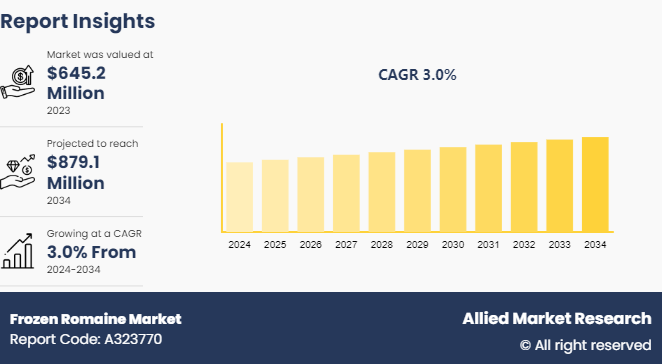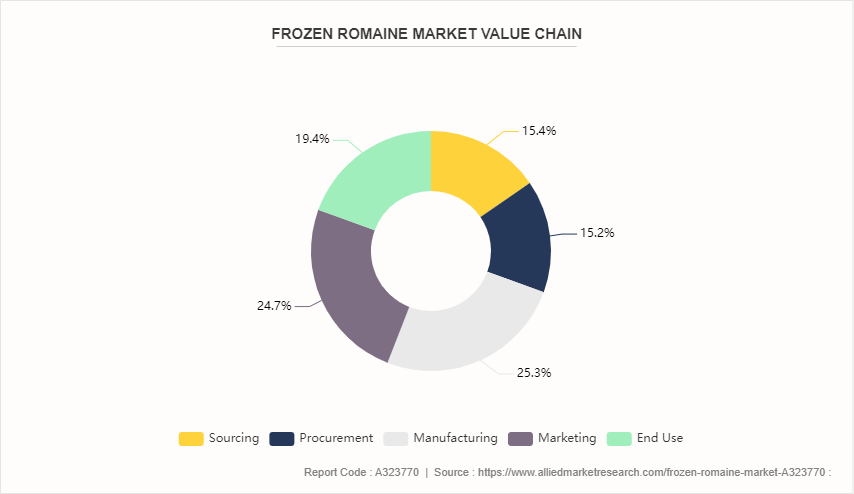Frozen Romaine Market Research, 2034
The global frozen romaine market size was valued at $645.2 million in 2023, and is projected to reach $879.1 million by 2034, growing at a CAGR of 3.0% from 2024 to 2034.

Market Introduction and Definition
Frozen romaine is romaine lettuce that has been washed, cut, and quickly frozen to preserve its freshness and nutritional value. It comes in various forms, such as whole leaves, chopped, or shredded, catering to different culinary needs. The different types include conventional romaine, organic romaine, and blends with other greens. Frozen romaine is widely used in salads, sandwiches, wraps, and smoothies. Its convenience and longer shelf life make it an ideal choice for households and food service providers looking to reduce waste and ensure a consistent supply of greens. Moreover, freezing helps retain the vitamins, minerals, and antioxidants found in fresh romaine, making it a healthy, year-round option.
Key Takeaways
The frozen romaine market forecast study covers 20 countries. The research includes a segment analysis of each country in terms of value ($Million) for the projected period 2024-2035.
More than 1, 500 product literatures, industry releases, annual reports, and other such documents of major energy storage system industry participants along with authentic industry journals, trade associations' releases, and government websites have been reviewed for generating high-value industry insights.
The study integrated high-quality data, professional opinions and analysis, and critical independent perspectives. The research approach is intended to provide a balanced view of global markets and assist stakeholders in making educated decisions to achieve their most ambitious growth objectives.
Key market dynamics
The frozen romaine market is significantly driven by the increasing consumer demand for convenience and year-round availability of healthy, fresh-tasting greens. As lifestyles become busier, more consumers are seeking quick and easy meal solutions that do not compromise nutrition. Frozen romaine fits this need perfectly, offering the convenience of pre-washed and pre-cut lettuce that can be quickly added to meals. Advances in freezing technology have played a crucial role, as they ensure the preservation of romaine’s texture, flavor, and nutritional content, making frozen romaine a viable alternative to fresh.
In addition, growing awareness of food waste has encouraged consumers and businesses to opt for frozen vegetables, which have a longer shelf life compared to fresh produce. This is particularly important in the food service industry, where managing inventory and reducing waste are critical concerns. Health trends advocating for increased vegetable consumption further propel the demand, as romaine lettuce is rich in vitamins, minerals, and fiber. The expanding availability of organic and sustainably farmed frozen romaine also appeals to eco-conscious consumers. Overall, the combination of convenience, waste reduction, health benefits, and sustainable options drives the popularity and frozen romaine market growth.
Many consumers believe that fresh vegetables are superior in flavor, texture, and nutritional value compared to their frozen counterparts. This perception is particularly strong with leafy greens like romaine lettuce, which are valued for their crispness and vibrant taste, qualities that can be compromised during the freezing and thawing process. The texture of romaine lettuce often changes after freezing, becoming less crunchy and waterier, which is unappealing in raw preparations such as salads.
Moreover, the market for frozen romaine is constrained by its relatively limited presence in retail outlets. Unlike more common frozen vegetables such as peas, corn, and broccoli, frozen romaine is not as widely stocked, which reduces its visibility and availability to consumers. This limited distribution be attributed to both supply chain challenges and a lack of consumer demand, creating a cycle that inhibits market expansion. Furthermore, the cost of producing and transporting frozen romaine is higher due to the specialized freezing equipment and temperature-controlled logistics required, often resulting in higher prices at the retail level. This price premium can deter budget-conscious consumers from purchasing frozen romaine, further restraining market growth. These factors collectively limit the broader adoption and growth potential of the frozen romaine market share.
The rising demand for convenience foods creates substantial opportunities in the frozen romaine market by aligning with the needs of busy, health-conscious consumers. As more individuals seek quick and easy meal solutions due to hectic lifestyles, the appeal of pre-washed, pre-cut, and ready-to-use frozen romaine lettuce increases. This convenience factor saves consumers significant time in meal preparation, making it an attractive option for those looking to incorporate healthy greens into their diets without the hassle of washing and chopping. In addition, the consistent quality and availability of frozen romaine ensures that consumers can enjoy their favorite greens year-round, regardless of seasonal variations.
Moreover, the trend towards convenience foods is not limited to individual households but extends to the food service industry, including restaurants, cafes, and meal kit services. These businesses benefit from the efficiency and reduced preparation time that frozen romaine offers, enabling them to meet customer demand for fresh-tasting, nutritious meals quickly. By supplying high-quality frozen romaine, producers can tap into a growing market segment that values both convenience and health. Furthermore, this synergy between consumer preferences and market offerings drives innovation and expansion in the frozen romaine market, fostering new product developments and broader market penetration.
Value Chain of Frozen Romaine Market
The frozen romaine industry value chain begins with the cultivation and harvesting of fresh romaine lettuce crops by farmers and growers. Strict quality controls and food safety measures are implemented during the farming and post-harvest handling stages. The freshly harvested romaine is then transported in a controlled environment to food processing facilities. At these plants, the romaine heads undergo cleaning, trimming, coring, and cutting into desired product forms like hearts, chopped/shredded pieces or keeping them as whole heads. Moreover, the prepared romaine then goes through blanching processes to inactivate enzymes and microbes before being rapidly frozen using technologies like air blast freezing or cryogenic freezing tunnels.
The frozen romaine in the desired product forms is then packaged into bags, pouches, trays, clamshells, or bulk containers based on customer requirements. Proper labeling with product details and coding happens at this stage. The packaged frozen romaine is stored in cold storage warehouses before distribution to various market channels such as food distributors, wholesalers, and importers/exporters. They supply end customers in the major foodservice/HoReCa segment including restaurants, hotels, and caterers. Furthermore, supermarkets, grocers, and online retail platforms facilitate distribution of frozen romaine packs to household/retail consumers. Food processors and manufacturers also source frozen romaine as an ingredient for value-added products.

Market Segmentation
The frozen romaine market is segmented into form, end use, distribution channel, and region. On the basis of form, the market is divided into frozen romaine hearts, frozen chopped romaine, frozen whole romaine heads. By end use, the market is segregated restaurants & hotels and household consumption. On the basis of distribution channel, the market is classified into specialty grocers, supermarkets/hypermarkets, and online channels. Region wise, the market is analyzed across North America, Europe, Asia-Pacific, Latin America and Middle East and Africa.
Regional/ Country Market Outlook
North America dominates the frozen romaine market due to several key factors that converge to create a favorable environment for market growth. First, the region boasts a highly developed food processing industry equipped with advanced freezing technologies that ensure the high quality and nutritional retention of frozen romaine lettuce. This technological edge allows North American producers to maintain the freshness and appeal of their products, meeting the high standards of both consumers and regulatory bodies. In addition, the widespread adoption of healthy eating habits and the growing demand for convenient, ready-to-eat food options drive the market. Consumers in North America increasingly prioritize nutritious, easy-to-prepare meals, aligning perfectly with the benefits offered by frozen romaine.
Moreover, the robust retail infrastructure in North America, characterized by extensive supermarket chains and online grocery platforms, ensures the broad availability and accessibility of frozen romaine products. The region's strong logistics and supply chain networks facilitate efficient distribution, minimizing spoilage and ensuring consistent supply. Furthermore, North America's significant disposable income levels and higher purchasing power enable consumers to afford premium and convenience foods, further bolstering market demand. Combined with targeted marketing campaigns that emphasize the health benefits and convenience of frozen romaine, these factors establish North America as the leading region in the frozen romaine market.
Industry Trends:
As there is rise in consumer preference toward healthy food adoption, the rate of frozen romaine adoption has increased by 12% approximately owing to various factors such as health and wellness trends, rise in awareness of frozen romaine, and increase in emphasis on health-conscious eating habits.
Competitive Landscape
The major players operating in the frozen romaine market include Dole Food Company, Fresh Del Monte Produce Inc., Bonduelle Group, Greenyard, Ardo Group, Birds Eye, McCain Foods, Hain Celestial Group, Pinguin and Findus Group.
Key Sources Referred
Food Safety Education
Plantphysiol Organization
Earth and Environmental Science
U.S. Bureau
Food and Agriculture Organization (FAO)
British Frozen Food Federation (BFFF)
The Soil Association
U.S. Department of Agriculture
Key Benefits For Stakeholders
- This report provides a quantitative analysis of the market segments, current trends, estimations, and dynamics of the frozen romaine market analysis from 2024 to 2034 to identify the prevailing frozen romaine market opportunities.
- The market research is offered along with information related to key drivers, restraints, and opportunities.
- Porter's five forces analysis highlights the potency of buyers and suppliers to enable stakeholders make profit-oriented business decisions and strengthen their supplier-buyer network.
- In-depth analysis of the frozen romaine market segmentation assists to determine the prevailing market opportunities.
- Major countries in each region are mapped according to their revenue contribution to the global market.
- Market player positioning facilitates benchmarking and provides a clear understanding of the present position of the market players.
- The report includes the analysis of the regional as well as global frozen romaine market trends, key players, market segments, application areas, and market growth strategies.
Frozen Romaine Market Report Highlights
| Aspects | Details |
| Market Size By 2034 | USD 879.1 Million |
| Growth Rate | CAGR of 3% |
| Forecast period | 2024 - 2034 |
| Report Pages | 340 |
| By Form |
|
| By End Use |
|
| By Distribution Channel |
|
| By Region |
|
| Key Market Players | Bonduelle Group, Findus Group, Hain Celestial Group, Fresh Del Monte Produce Inc., McCain Foods, Birds Eye, Dole Food Company, Ardo Group, Greenyard, Pinguin |
The global frozen romaine market size was valued at USD 645.2 million in 2023, and is projected to reach USD 879.1 million by 2034
The global frozen romaine market is projected to grow at a compound annual growth rate of 3.0% from 2024-2034 to reach USD 879.1 million by 2034
The major players operating in the frozen romaine market include Dole Food Company, Fresh Del Monte Produce Inc., Bonduelle Group, Greenyard, Ardo Group, Birds Eye, McCain Foods, Hain Celestial Group, Pinguin and Findus Group.
North America dominated and is projected to maintain its leading position throughout the forecast period.
Consumers are increasingly prioritizing health and wellness, leading to a higher demand for frozen vegetables, including romaine lettuce. As people become more health-conscious, the convenience and nutritional benefits of frozen romaine make it a popular choice.
Loading Table Of Content...



